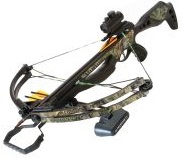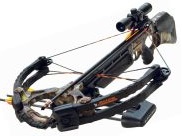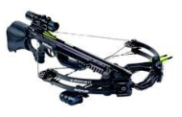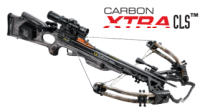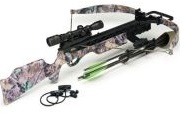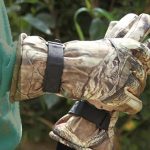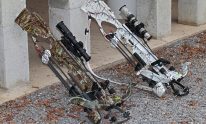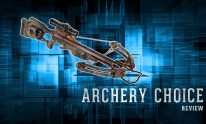Similar Articles
Crossbows date back to ancient China, when Chinese warriors learned they could mount a bow on a stock, called a tiller, to create a powerful weapon that often exceeds traditional bows in deadliness. Today, the best crossbow can deliver as much as 440 FPS, literally providing enough kinetic energy to take down an elephant (where it’s legal, of course).
While there are fewer crossbows on the market than traditional and compound bows, selecting the best crossbow for the money can still be a cumbersome task that requires hours of research. We hope to make that job easier for you by providing you, gentle reader, with a list of the best crossbows in all the major price ranges. We also give you a link to our review of that particular crossbow, so you can use the information we have gleaned in making your purchase decision.
Best Crossbows For The Money (Different Price Points)
back to menu ↑Best Crossbow On a Very Tight Budget
Arrow Precision Inferno Fury – Check Price on Amazon.com
The Arrow Precision Inferno Fury is a great starting crossbow, useful for learning the ins and outs of crossbows if you have never shot one. The Inferno Fury is inexpensive, lightweight, and simple to assemble and use, making it perfect for beginners. It also comes with everything you need to get started with target practice, including 16” arrows.
This crossbow is relatively slow, flinging arrows at only 235 fps with barely 40 ft. lbs. of kinetic energy. This may not be adequate for hunting anything other than small game like groundhogs or rabbits, and those only at short range. However, the crossbow will work fine for short-range target practice and training. Read our review of the Inferno Fury.
The crossbow also includes a decent red dot scope, which is a nice addition to the bow. One of the best features of crossbows is the ability to use a scope for shooting. The red dot scope included with the Inferno Fury is decent, but many users will probably want to invest in a higher quality red dot scope at some point. Any scope other than a red dot would be wasted on this crossbow, though; it’s slow speed and low kinetic energy make it almost worthless beyond 30 yards, so a red dot scope is almost always sufficient for shooting.
Summary:
- Inexpensive, lightweight, compact beginner crossbow
- Very comfortable to hold and easy to aim
- Modern safety features, such as an anti-dry fire system and thumb guard, have been built into the crossbow
- Useful only for small game, if you’re looking to use it for hunting
- Can be used with the included 16” arrows or 20” carbon arrows
Best Inexpensive Crossbow:
The Barnett Jackal – Check Price on Amazon.com
The Barnett Jackal is an excellent choice of a crossbow, useful for both target shooting and hunting. The detailed, photograph-rich assembly instructions make it so easy to assemble that even a beginner should be able to have it up and running within 20 minutes. The Jackal includes a 3-red dot scope, which can be switched between green and red dots depending on lighting conditions, with 5 brightness settings for the dots.
The Jackal fires arrows at 315 fps, with 84 ft. lbs. of kinetic energy. With this speed and force, Barnett’s Jackal is capable of killing some of the largest game North America has to offer, including elk and cape buffalo. The crossbow is solid and dependable, and feels good to hold and shoot. The only downside to this crossbow is the durability of the string, which needs to be waxed every 5 shots or so to maximize its lifespan. Our Jackal’s string began to separate and fray after around 700 shots fired. Read our review of the Jackal.
Like the Inferno Fury, the Barnett Jackal comes with arrows and the red dot scope. These arrows are much better quality, though: Easton 20” arrows that are quite acceptable for either target use or hunting. The arrows are also durable, surviving point blank range shots at our foam target without bending or cracking.
Summary:
- 3.5 lbs. trigger pull is very solid and dependable
- Includes anti-dry fire mechanism
- Scope is easy to sight and stays zeroed in reliably
- Very stable and excellent distribution of weight
- Inexpensive crossbow, but highly useful for either target shooting or hunting
Best Mid-Priced Crossbow:
Barnett Buck Commander – Check Price on Amazon.com
The Barnett Buck Commander looks beautifully vicious, with its foot stirrup integrated into the riser to make it more aggressive-looking. It fires accurately with enough power to take down the largest game available in North America. This crossbow has a draw weight of 175 lbs., more than enough to give its arrows speeds of up to 365 fps, with 126 ft. lbs. of kinetic energy.
Barnett includes an excellent scope with the Buck Commander, with 3x magnification and illuminated reticles. The scope came sighted in out of the box, so we were quickly using the crossbow to target practice instead of just sighting it in. Read our review of the Buck Commander.
Because of its price tag, the Buck Commander might be considered best for intermediate to advanced shooters, but the truth of the matter is that the crossbow is excellent for beginners as well. In fact, the Buck Commander will “grow” with its shooter, maintaining accuracy from 20 yards all the way up to 70 yards.
Summary:
- Comes with a rope cocking device, essential for safely and consistently drawing the string of any crossbow
- Very quiet to shoot, with little to no recoil
- Foot stirrup built into the riser, giving it an aggressive look while making it safer to cock
- Illuminated crossbow scope with multiple reticles
- Crossbow “grows” with its user, remaining accurate out to 70 yards in the hands of a skilled shooter
Best High-Priced Crossbow:
Barnett Ghost 410 – Check Price on Amazon.com
The Barnett Ghost 410 is well worth the money you spend on it, being a very forgiving crossbow. Although it has an excellent anti dry fire mechanism, Barnett claims its Carbon Riser Technology riser can withstand up to 1,000 dry fires before failure. This claim is almost unheard of, considering the danger that dry firing a crossbow poses to its shooter and everyone around it.
The Ghost 410 is extremely powerful, packing kinetic energy of 149 ft. lbs. behind the arrows, which fly at 410 fps. This crossbow is powerful enough to take on any game you might want, including moose and grizzly bears. The crossbow is heavier than other crossbows we’ve looked at so far, weighing in at 7.5 lbs., but it’s made to last and be comfortable to shoot. Barnett has even gone so far as to make the fore-grip moisture resistant and able to help keep your palm warm when shooting outdoors in cold weather. Read our review of the Ghost 410.
The scope is well made, and came sighted in right out of the box. It has four reticles, and is moisture and fog resistant. This scope also has excellent light gathering capabilities, providing clear shots in the dark with only moonlight to illuminate our targets.
Summary:
- Excellent hunting crossbow, with a value far exceeding its price tag
- The type of accessories included are things you would upgrade to if you purchased a less-expensive crossbow
- One of the fastest and most powerful crossbows on the market
- Quad-limb design with foot stirrup integrated into riser to give an aggressive look.
- Includes a rope cocking device, essential for pulling the 185 lbs. draw weight
Best Crossbow For Big Game Hunting:
TenPoint Carbon Xtra CLS – Check Price on Amazon.com
TenPoint’s Carbon Xtra CLS crossbow is perhaps the most expensive crossbow money can buy, but it is packed with features and accessories that make it well worth the money…if you have enough of it to spend. Not only does it come with arrows and a premium scope, but it also includes both a soft case and a hard case for a variety of travel and storage situations, and an aluminum monopod for added stability when shooting, making it the ideal crossbow kit for a hunting safari. It shoots arrows at 345 fps with 112 ft. lbs. of kinetic energy.
The included scope has 1.5x magnification, and is one of the best scopes on the market. It has excellent light-gathering capabilities, but is still illuminated for those times when there simply is no light to be had. The dots are small and bright, making them perfect for hitting long-range targets.
The TenPoint Carbon Xtra CLS comes with not only field points, but broad heads as well. In fact, the crossbow package includes a full dozen arrows, 6 with field points and 6 with broad heads. If you want more arrows, just make sure they are 20” long and have a total weight of 425 grains.
Summary:
- One of the most expensive crossbows on the market
- Includes one of the most complete set of accessories of any crossbow, including an integrated ACUdraw crank-cocking device, RangeMaster Pro Scope, Elite Hunter arrows with field points and broadheads, monopod, and both a hard case and soft case
- Accurate and powerful out to 80 yards
- One of the best crossbows available today
- Lifetime warranty on crossbow; 5 year warranty on ACUdraw cocking system
Best Recurve Crossbow:
The Excalibur Axiom SMF – Check Price on Amazon.com
Excalibur’s Axiom SMF is in our opinion the best recurve crossbow on the market. It has a draw weight of 175 lbs., which will hurl the arrow at a whopping 305 fps with exactly 80 ft. lbs. of kinetic energy. The Axiom SMF is perfectly suited for hunting small game as well as large game, having been used to take down elk and bears by many hunters.
Excalibur packs the Axiom SMF with the highest quality optics, a 2.5x scope with multiple reticles. The scope comes almost sighted in out of the box; we had our scope zeroed in within 2 shots. This is one of the finest scopes you can get for a crossbow, and has given us clear shots even in foggy weather. Read our review of the Axiom SMF.
The Axiom SMF is terrific for intermediate to advanced shooters, but is also useful for beginners. Its light weight, excellent weight distribution, and deadly accuracy make it easy to learn the proper shooting technique without any interruptions. An 11-year old who fired our Axiom SMF fired 3 bulls-eyes in a row from 20 yards when he shot the crossbow; it was his first time ever shooting a crossbow!
Summary:
- Includes a rope cocking device, which is almost a must-have for any crossbow shooter
- Lightweight at only 5.8 lbs., making it easy to transport and carry
- Excellently suited for hunting all sizes of game; we actually found a video of a man using an Axiom SMF to take down an adult elephant
- Powerful and deadly accurate
The Overall Best Crossbow
And the Grand Prize goes to: Barnett Ghost 410 The Barnett Ghost may not be the most expensive crossbow on the market, but it is still the best hunting and most versatile crossbow money can buy. Its power, accuracy, reliability, and comfort make it suitable for beginners, intermediate shooters, or advanced hunters. It includes a scope that other crossbow hunters will drool over, and will serve you well in any big-game hunt you might endeavor within North America. Read our review of this x-bow.
back to menu ↑What to Look for When Choosing a Crossbow
There are a lot of options available to hunters and shooters with modern crossbows. Often times, the features can be so numerous that they can actually become confusing to all but the most experienced of archers. As such, we have compiled a list of the most important features or options you may want to look for along with an explanation of what each does and how it can impact your accuracy, comfort and hunting success.
back to menu ↑Most Important Safety Features
When choosing a crossbow, especially as a beginner to shooting one, it is very important to examine the features built in to keep the shooter safe. There are a number of important safety features, especially for someone getting used to pulling the trigger on a crossbow for the first time, so below we explore some of the best things to look for when selecting a crossbow.
Auto Safety
Just about any modern crossbow is going to have some type of mechanical safety which will keep the trigger from being inadvertently pulled. This is fine if you are an experienced crossbow user, but is something that is easy to forget to engage when there are so many other things going on during the cocking and loading process. Some crossbows have an auto-engaging safety, which means the safety is set to the on position during the cocking process, ensuring users of all skill levels always have the trigger unable to be pulled until they manually disengage the safety.
Anti Dry Fire
No archery equipment, whether a vertical bow or a crossbow should ever be fired without an arrow in place. When this occurs, it is called a dry fire and, other than running over your bow with an F350 dually, is just about the worst thing that can happen to your bow. Dry firing puts an incredible amount of stress on the bow limbs and can actually cause them to crack or even shatter in the process. It makes a great safety enhancement to have a mechanism that blocks the trigger from firing unless an arrow is in place. This keeps the trigger from firing even if the safety is off unless an arrow is in place. A lot of shooters think they will never forget to place an arrow on the rail, but when you are not used to shooting a crossbow, it can actually be quite easy to do, as the cocking of the bow is a separate step from actually loading the arrow.
Front Grip Design
Anyone not familiar with a crossbow’s shooting characteristics could ending learning a painful lesson regarding the forward shooting hand and the string path. The string on the crossbow actually goes right over the top of the forward hand when firing, and if a finger or thumb is sticking up, it can be a very painful lesson. Many crossbows incorporate wings into their front grip design which make it virtually impossible for you to place your fingers in the string path. These wings protrude to the side along the top edge of the forward grip creating a good physical barrier to keep your hand safe, and to give you one less thing to have to think about.
Most Important Comfort Features
When selecting a crossbow, many aspects come into play with the most common being the speed and power of the crossbow. What a lot of users forget to really examine is how well the physical aspects of the crossbow are going to match their size and strength. Having a crossbow fit the shooter is incredibly important to ensure consistent and accurate shot placement.
Adjustable Stock
Not all shooters are going to have the same dimensions in terms of height and reach. Having a crossbow that offers an adjustable length of the stock can be an advantage in multiple ways. First, it means that multiple different shooters can use the same crossbow as each can configure the length to their specific needs. This can go a long way towards helping keep the shooting within the family budget while encouraging more of the family to get into the sport. It can also allow for a single shooter to custom fit the LOP (Length of Pull) to their needs in varying conditions. This can come in to play when you might be practicing with only a t-shirt on and then hunting in a large this jacket. Being able to adjust the stock for the thickness of clothing ensures you are always at a consistent shooting length. The adjustable stock can also make the crossbow more portable. Having the ability to shorten the overall length by a couple of inches can make for a more comfortable sling experience and can also make the bow easier to get into a tree stand.
Weight
The weight of a crossbow is something that each shooter will need to evaluate based on his or her specific needs as each individual’s requirements are likely to vary with how they intend to use their xbow. Having a lightweight crossbow can mean a greater level of portability when walking to the tree stand or blind during hunting season. It can also mean being able to hold the crossbow in a shooting position for a longer period of time when firing offhand. Where a heavier crossbow comes into play is when going to pinpoint accuracy. In general, the heavier any weapon is, the more stable it is in a firing position using a rest. They crossbow simply will not move off target as easily and can actually afford the shooter a bit of altitude if their trigger ‘pull’ isn’t a great trigger ‘squeeze’.
Center of Gravity
The center of gravity on a crossbow (or rifle for that matter) is the point along the length of the weapon where there is equal weight in front and behind. This is important as it can affect how a crossbow feels to a specific shooter. Having more weight forward can actually give a bit of stability when shooting from a rest, but is going to make for more forward arm fatigue when shooting offhand. Recent designs in crossbows are now leaning more towards a bullpup design, where more of the weight of the crossbow is placed closer to the shooter’s shoulder. This can make a huge difference when firing offhand as it allows for a more stable platform as the weight is closer to the body and being supported as much by the forward shooting arm.
back to menu ↑Most Important Accessory Features
The list of potential accessories to mount on a crossbow are literally as unlimited as the user’s imagination. From laser sights to tactical lights, if you can dream it, you can probably find it. Below we discuss the more common accessory features, what they do, and how they can help you in both shooting as well as hunting situations.
Picatinny Rails
Picatinny rails are military spec mounting points that are becoming more popular on crossbows. They are derived from the AR rifle platform and essentially allow you the ability to mount just about any type of accessory on your crossbow that you might mount on your AR rifle. Many manufacturers are moving their scope mounts to this design as well as adding an accessory rail under the barrel of the crossbow.
Vertical Foregrips
There are various designs of the vertical foregrip, but almost all of them will mount to a Picatinny rail on the underside of the barrel. The vertical foregrip allows you to hold the crossbow with a bit more comfort and also places your forward hand low enough that it will always be clear of the string path. It can also be handy when shooting for a low rest as it raises the crossbow up a bit to a more comfortable shooting position. The disadvantage to a vertical grip is, since it raises the shooting height, it might make the shooting position too high from a higher rest. It can sometimes also make offhand shooting a bit less accurate as you cannot brace to forward shooting arm against your body. If you want the tactical feel of the vertical foregrip but also want the ability to shoot from a regular foregrip, there are many manufacturers that offer a multi-position vertical grip. This allows you to depress a button on the side to fold the foregrip from a vertical position to against the underside of the barrel, making for a more traditional forward grip.
Removable Quivers
Whether heading to the range or into the field for hunting, having your arrows in a quiver is always a good idea. A good quiver will not only eliminate the chance of stepping on an arrow, but will also keep the field points or broadheads secure and covered, protecting the edge as well as the shooter. The easiest way to carry the quiver is mounted to the crossbow as it is one less item to have to remember or hold on to during your trek. Once it comes time to shoot, however, having a quiver full of arrows protruding to the side or from the bottom of the crossbow can become a bit of a detriment. This is where the removable quiver comes in to play. Being able to attach the quiver to the crossbow for transport, and then easily detach once it comes time to shoot offers the ‘best of both worlds’ for arrow storage. Many manufacturers have gone to this system and many aftermarket accessories will allow for removable mounting as well.
Cocking Aids
Most modern crossbows get much of their high speeds from better technologies, but they also still require high draw weights to achieve this. It is not uncommon to find draw weights well over 150 pounds and even upwards of 200 pounds. To attempt to draw a crossbow in this draw-weight range without some form of assistance would be futile to say the least for only but the absolute strongest of shooters. It would also likely lead to increased inaccuracy as the string wouldn’t be centered from shot to shot. There are two main classes of cocking aids to assist shooters in properly cocking their crossbow while also helping to lessen the load on the shooters shoulders when cocking.
Rope Cocking Aid
The rope cocking aid, or rope cocker as it is sometimes referred to is basically something that is used to assist in the cocking of the crossbow that drops the felt draw weight by approximately 50%. These are rather inexpensive and are somewhat universal, the only major factor being the length of the rope. This will still require some effort to cock the crossbow, but will make the process much more manageable for most shooters.
Crank Cocking Aid
The crank cocking aid is a cocking aid that either attaches to the stock of the crossbow or is permanently mounted inside the stock. It features a rope that extends on either side of the barrel to attach to the string, and then uses a gearing system to allow the shooter to simply turn the crank to pull back the bowstring. This is typically a more expensive cocking aid but one that allows virtually any shooter to cock the crossbow as the amount of force required is very minimal. This is typically a cocking aid that is not universal and usually either comes as part of the crossbow or is available only from your crossbow manufacturer.
back to menu ↑Most Important Hunting Features
Every hunter is going to have their own specific needs from any of their gear, and this holds true with crossbows. There are a few features we have found seem to be fairly consistent across most crossbow shooters, however, and we discuss the most common below.
Portability
There are many schools of thought on crossbow accuracy that can revolve around the width of limbs or weight of a crossbow making a difference in the accuracy. While there may be some truth to this, we have found that most shooters will never practice enough to attain a shooting level where they would actually notice the difference. In short, we have found that most crossbow can outshoot their users. As such, looking at a crossbow that is very portable is a great advantage for use in the field. Portability is typically noticed most in weight and in the width of the limbs. Weight we have discussed previously but limb with (also called axle to axle (ATA)) length can be very important in hunting situations, especially when hunting from tighter quarters. Unlike a rifle, the crossbow must have clearance for the limbs to release to ensure no contact is made with any objects during firing, which could result in a miss and/or damage to the crossbow. Having a narrow ATA translates to being able to shoot in more situations, meaning more opportunities for taking a shot.
Quietness
Even with the high speeds of many of today’s crossbows, keeping the sound level down when firing a crossbow can be critical to your hunting success. Looking at a crossbow arrow fired from a range of 35 yards at 350 fps (which is a good average speed for a fast crossbow in a real world hunting configuration), the arrow will take 0.3 seconds to reach the target. The sound from the shot will reach that same target in about 0.09 seconds, meaning the target is going to have 2/10 of a second to react. This may not seem like a lot of time, but that is plenty for your prey to have moved enough to make the shot a bad one, or a miss entirely. Crossbows are inherently noisy due to the high acceleration and deceleration of the strings and cables when firing. Finding a crossbow with multiple sound dampeners in place that still shoots at a good speed is paramount to your hunting success. Additionally, don’t forget to add dampeners to the foot stirrup. These will not affect shooting performance, but they will quiet the crossbow as much of the vibration from the shot will be transferred to the forward-most point of the crossbow, which is usually the stirrup.
Speed
The speed of a crossbow is measured in feet per second (fps) and can be used, along with the total weight of the projectile, to calculate the force that an arrow will have at impact. Basically, the higher the speed, the more force a projectile will have at impact. Many new shooters only look at the speed of their crossbow without ever realizing what that means for them. While speed is very important in trajectory and killing power, it can also be detrimental to have too much speed. Basically, as you increase the speed of a projectile, you also decrease the margin for error. As an arrow gets faster and faster, each tiny imperfection in either the arrow, the crossbow or the shooter will become more apparent. Shooting a heavier arrow at a slower speed will allow for a much larger margin for error while shooting a lighter arrow at higher speeds produces a faster shot, but with less room for error. All in all, it is important for each shooter to know their abilities, including equipment, to ascertain what the best range of speed is for them.
back to menu ↑How Important is Speed?
Every shooter is going to have their own opinion on this question and with good reason…the best speed of a crossbow will not be the same for all shooters. There are shooters of varying skill levels that will need more speed, and others will do better with less speed. Why? Take a look below to see the pros and cons of higher speed.
Pros
The faster any projectile moves, the flatter the trajectory it will have. What this means to anyone shooting an arrow, is that the margin for error when estimating distances is going to be better. A higher speed projectile is also going to pack more punch, grain for grain, which will translate to a more effective hunting shot. There are many crossbows currently on the market that will shoot arrows in the mid 300 fps range, and even some that are now breaking the 400 fps speed barrier as well.
Cons
As with most things in life, you can’t get something without giving something up. So why would you want an arrow to go slower? First off, as a crossbow’s arrow speed decreases, the margin of error for the shooter increases. That is to say, if you are shooting a slower crossbow and make a slight mistake, it will not be as apparent in the shot. If you are shooting a super-fast crossbow and make even the slightest error, that error is going to be amplified by the high speed and will really show in the shot in the form of a poorly placed arrow. By slowing down a bit, a shooter actually affords themselves a better opportunity for a well-placed shot as there will not be that amplification factor that would exist with more speed. So what is the best speed? We have found that an arrow going in the 310 to 340 fps range is going to produce consistent shots for most shooters and will also pack plenty of punch (assuming a total projectile weight of around 400 grains) to bring down most animals in North America.
back to menu ↑What is Best, Compound or Recurve?
We are often asked about the differences in a compound versus a recurve crossbow. This is a question especially often asked by new shooters, although we have spoken with plenty of experienced shooters that also want to learn more about the difference in a compound and recurve. Remember, there is no such thing as a dumb question…if you don’t know, then asking is the only way to learn (unless you just visit our site often, where we work to answer the questions BEFORE you have to ask!)
Compound Pros
Most modern crossbows on the market are compound bows so this category is going to offer you the largest selection. A compound crossbow bow works with a series of pulleys (often referred to as cams due to their out of round shape) and cables that allow for an amount of draw weight to be reduced as the crossbow reaches the end of its draw. This is referred to as the ‘let off’ and you can feel that reduction in draw weight as you get to the end of the draw and the crossbow cocks. This results in less effort to cock, and less stress on the limbs as the crossbow remains cocked while waiting for the shot. This also means you can often get more draw weight in a smaller package, allowing for a more portable yet more powerful crossbow.
Compound Cons
So given the advantages of a compound crossbow, why would anyone not want one? For one, as you add more moving parts (which a compound certainly has more of), you are going to increase the chance that something can go wrong. As you introduce additional cables and pulleys, you introduce more potential failure points. This is not to say that compound crossbows are destined to fail, but rather to say there is more potential for failure to happen…and it will likely not be at an opportune time! Another issue with a compound crossbow is that you will need some type of bow press should you wish to change cables and/or stings, or if you want to thread a silencer into the string. There are portable bow presses available, but it still means an extra piece of equipment you have to haul with you to the range or into the field. One other potential disadvantage with a compound crossbow is going to be weight. There are some compound crossbows that are actually very light, but in general, a compound crossbow is simply going to be heavier than its recurve counterpart due to all of the extra parts found on a compound. One or two pounds of additional weight may not seem like a lot, but after hauling it all day in the field, that extra weight can become painful apparent.
Recurve Pros
So what are some of the advantages of a recurve crossbow? For one, the answer is simplicity. A recurve bow is the most classic design, tried and tested for literally hundreds of years. It is simply a set of curved limbs and a string connecting them. When you want to shoot, you draw that single string back until the crossbow is cocked, add an arrow, and you are ready to shoot! There are very few moving parts, and as such, very few potential failure points. Another advantage of the recurve crossbow is the ability to change a string, in the field, with no special tools. It may take a bit of strength, but a shooter and take enough tension off of the string to change it out in most cases without the use of a bow press. Also, due to the fewer moving parts, a lot of recurve crossbows are actually quieter than their compound counterparts. With only a single string moving and no cables or pulleys involved in the release of the arrow, there are fewer pieces to make noise.
Recurve Cons
So, after all those positives on the recurved, why wouldn’t everyone be jumping at the chance to own one. Selection (or lack thereof) has something to do with that. While there are a number of quality recurves offered by some well-known manufacturers, there simply are not near the number of models available as with comparable compounds. The fact that a recurve has no let off also means that it is going to be a bit more difficult to cock. Many recurves actually have to employ a higher draw weight to achieve the same speeds as compound crossbows enjoy. Keep in mind anytime you are looking at recurve crossbows that when they list the fps speed of the crossbow, it might be with a much lighter arrow than a competing compound crossbow uses. One other potential drawback of a recurve crossbow is the size. Many recurves have to employ larger limbs to achieve their desired speeds. This translates to a crossbow that can be several inches wider than a compound. That is not to say that there aren’t some wide compound crossbows out there, but speed for speed, you are likely to find the recurve to be much wider, meaning it will require a greater clearance in the field for shooting.
What are the Best Targets?
When selecting a target to be used with a crossbow, it is very important to ensure the target is built to handle the speed and power of modern crossbows. A standard archery target for a vertical bow is not going to be able to effectively stop a high speed crossbow arrow. The biggest issue is going to be with over penetration, where the arrow is likely to blow right through the target, meaning you will have to look for the arrow and will also likely have ruined vanes.
There are two basic classes of crossbow target, one that is heavy and meant to keep around the range, and one that is portable for taking into the field and often called a ‘discharge target’. The heavier target is designed for multiple shots without falling over, while the discharge target will likely be knocked over from the impact of the arrow as it is much lighter for more portability. If you are new to crossbows, it is important to note that unlike a vertical bow, most crossbows cannot be de-cocked and must be fired to release the string, hence the need for a good discharge target. The most important feature of a good target aside from stopping an arrow is how easy the arrow is to remove from a target. Many targets will actually require an arrow puller to get the arrow out while a few of the best targets provide for easy one handed removal.
So what is the best stationary target?
We tested many different stationary targets and found the Morrell Yellow Jacket to be our main ‘go to’ target. At a size of 20” by 20” and a weight of about 30 pounds, the Yellow Jacket has done an excellent job stopping crossbow arrows of all speeds, while allowing for one handed arrow removal. It is a bit heavy if you are going to be moving it around a lot, but that weight means the target isn’t going to move even after multiple shots. It is worth noting that the 8 year old daughter of one of our shooters (who is actually quite the shooter herself) can easily remove crossbow arrows from this target without assistance.
What is the best discharge target?
Like its big brother, we found the Morrell Yellow Jacket Discharge Target to be the most effective target in this class for effectively stopping an arrow and for ease of arrow removal. At a mere 6 pounds and 10” by 16” dimensions, the Yellow Jacket Discharge Target is very portable for field use. We would strongly recommend only discharging a field point into this bag to decrease the chance of an arrow pass through.
back to menu ↑What Can You Learn From Our Crossbow Reviews?
Our reviews follow a rather unconventional pattern: rather than writing long paragraphs of text, we prefer to focus on bullet points, which are in our opinion easier to grasp. Each review includes the following sections:
Package Contents
Here we list the items and parts you can expect to receive with your crossbow package. Package contents do change from time to time as the manufacturer might add or remove certain items, and we try to stay on top of things by updating this section often. This is where you’ll learn if the crossbow comes with a rope cocking aid, if a maintenance kit is included, what type of arrows come with the x-bow, and what type of sight and quiver are in the package.
Assembly Instructions
Assembling a crossbow is usually very easy, and involves attaching the riser to the stock, mounting the quiver and scope, and fixing the foot stirrup. In some cases there might be some extra steps you might take, which we will list in that section. Some crossbow manufacturers include assembly DVD’s, which make the process considerably easier. In this section you’ll also learn if assembly hardware (bolts, screws, keys) are a part of the crossbow package.
Riser, Stock, Limbs, Safety
This is where we focus on the technical stuff. You’ll find out about the quality/durability and the materials used in the making of the riser, stock and limbs. You’ll find out if certain parts are prone to damage and might require frequent replacing. Safety is also discussed here, and you’ll learn whether an anti-dry fire device is included, whether a fore-grip thumb-hole is available, and how comfortable and easy the crossbow is to shoot.
Trigger Action
Here you will find out what pressure is required to pull the trigger, how long is the trigger travel distance, and whether the trigger assembly requires lots of lubrication to keep operating smoothly.
Shooting Speed & Kinetic Energy
The shooting speeds (FPS) advertised by crossbow manufacturers isn’t always accurate. We therefore perform our own tests with a chronograph, using the arrows included with the crossbow, and present our own shooting speed results. We also calculate the point blank kinetic energy of the arrows to make it easier for you to determine what type of game animals you can hunt with this crossbow.
Shooting Accuracy
The accuracy of an x-bow is very strongly related to the shooter’s skill level and experience. However, there are certain things about a crossbow that can negatively or positively affect accuracy, such as:
- The quality of the sight / scope
- How comfortable the crossbow is to aim
- The reliability of the trigger
- Weight distribution across the crossbow and whether it’s balanced or not
Each of our crossbow reviews includes very detailed information regarding the above, so make sure to always check out the “shooting accuracy” section, which is likely the most important one to read. Additionally,
Information Regarding Arrows
Crossbows are generally sold with a pack of 3 to 6 arrows, which are of a certain length and type. In this section of our reviews we provide you with this information so that you can easily purchase additional arrows that will suit the crossbow in question perfectly. Keep in mind that while it’s OK to purchase arrows that are slightly longer than recommended by the manufacturer, shorter arrows should be always avoided.
Who It’s Best For
Not all archers crossbow shooters are alike; some are beginners, some are experienced shooters. Some want to hunt, others only want to do some target shooting in their backyard or at the range. Whatever your experience level and goals, we’ll provide you with all the information you need to help determine whether the crossbow in question will be suitable for your needs. For instance:
Hunters will learn whether the crossbow is light enough to carry in the field, whether it’s small enough to easily maneuver in a tree stand or a hunting blind. We’ll also tell you what type of game animals you can expect to harvest with this x-bow, based on its kinetic energy output. You’ll usually also find examples of game harvested, including the distance from which the successful shot was taken.
Beginner shooters will learn whether the crossbow is suitable for them. For an x-bow to be a good choice for a beginner, it should be safe to use, easy to maintain, have a responsive and beginner-friendly trigger assembly, and ideally be inexpensive; most beginners after all won’t be prepared to spend $1000 on a crossbow if they’ve never shot one in the past.
back to menu ↑Info About The String
The quality of the string varies from crossbow package to another. In this part of our reviews, we give you an estimate of how many arrows you can expect to shoot out of the crossbow before the string starts showing signs of wear and needs to be replaced. Depending on the quality of the package, this will usually be anywhere between 500 an 1500 arrows. Keep in mind that the more often you wax the string, the longer it will generally last.
back to menu ↑Recommendations on Where To Purchase The Crossbow
We research available deals online and try to recommend the best place for you to purchase the reviewed crossbow. In most cases this will either be Amazon.com or Cabelas.com, which offer the best prices, fastest shipping and largest selection of accessories. It’s always a good idea to check with your local sporting goods shop or archery pro shops (if available in your area) as they might be stocking crossbows that would otherwise be very difficult to purchase. Just keep in mind that these stores will usually charge you significantly more than an online shop will.


